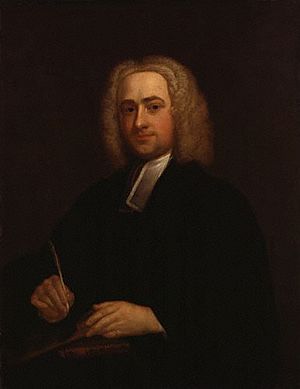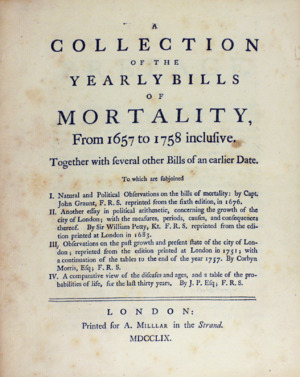Thomas Birch facts for kids
Quick facts for kids
Thomas Birch
|
|
|---|---|
 |
|
| Born | 23 November 1705 |
| Died | 9 January 1766 (aged 60) |
| Nationality | British |
| Occupation | Historian and Keeper of books at British Museum. |
| Known for | Fellow of the Royal Society |
Thomas Birch (born November 23, 1705 – died January 9, 1766) was an English historian. He was known for writing many books and for being a member of important groups like the Royal Society.
Contents
Early Life and Career
Thomas Birch was born in Clerkenwell, London. His father, Joseph Birch, made coffee mills. Young Thomas loved to study more than he liked business.
His parents were Quakers, a Christian group. Because of this, he did not go to a university. However, he became a deacon in the Church of England in 1730. A year later, in 1731, he became a priest.
Friends in High Places
Thomas Birch was a strong supporter of the Whigs. This was a major political group in Britain at the time. He became friends with Philip Yorke. Yorke later became the Lord Chancellor, a very important legal position.
This friendship helped Birch a lot in his career. He was given many church jobs in different places. Eventually, he worked in London.
A Unique Fisherman
Thomas Birch was also known for his love of fishing. He even had a very unusual way to catch fish! He would dress up like a tree. His clothes made his arms look like branches. His fishing rod and line looked like a spray of flowers. He believed that if he moved, the fish would think it was just a gentle breeze.
Important Groups and Later Life
In 1735, Thomas Birch joined the Society of Antiquaries. This group studies history and old things. He was also chosen to be a member of the Royal Society. The Royal Society is a famous group that promotes science. He served as its secretary from 1752 to 1765.
In 1728, he married Hannah Cox. Sadly, she passed away the very next year.
His Death and Legacy
On January 9, 1766, Thomas Birch died after falling from his horse. He was buried in the church of St Margaret Pattens in London. He was the rector (head priest) of that church at the time.
In his will, he left his large collection of books and writings to the British Museum. He also left about £500. This money was meant to help increase the pay of the three assistant librarians there.
Thomas Birch's Writings
Thomas Birch wrote a lot of books and papers. Some people, like Horace Walpole, didn't always agree with his writing style. He thought Birch lacked "taste and judgment."
Even Samuel Johnson, a famous writer, had something to say. Johnson said that Birch was "as brisk as a bee in conversation." But when he picked up a pen, it was like a "torpedo" that made him slow down.
Working with Publishers
Birch often worked with a successful London bookseller named Andrew Millar. Together, they published some of Birch's most popular works. These included:
- The Works of the Honourable Robert Boyle (1744)
- A Complete Collection of the Historical, Political, and Miscellaneous Works of John Milton (1738)
Key Publications
Birch wrote most of the English biographies in a large book called the General Dictionary, Historical and Critical (1734–1741). He also helped write the Athenian Letters (1741–43). He edited important historical documents like the State Papers of John Thurloe (1742).
Some of his other notable works include:
- Inquiry into King Charles I's involvement with Irish rebels (1756)
- Historical view of Negotiations between the Courts of England, France and Brussels 1592-1617 (1749)
- Life of Archbishop Tillotson (1753)
- History of the Royal Society of London (1756–1757)
- Life of Henry, Prince of Wales (1760)
- The heads of illustrious persons of Great Britain (1761), which included copper plate pictures and biographies.
After he died, some of his papers were published in 1848. These included The Court and Times of James I and The Court and Times of Charles I.

Copies of Benjamin Franklin's Letters
An American researcher, Alan Houston, recently found some interesting papers at the British Library. These papers were titled Copies of [Benjamin Franklin's] Letters relating to the March of General Braddock.
Thomas Birch was known for copying any historical documents he could find. He was friends with Franklin, and they were both members of the Royal Society. In his own autobiography, Franklin mentioned a "Quire Book" that has never been found. This book contained letters and papers about his efforts to help the British Government before the American Revolution.
The copied letters talk about Franklin's efforts in 1755. He helped the British Redcoats led by General Braddock. They were marching to fight the French at Fort Duquesne (which is now Pittsburgh). Braddock desperately needed ways to move his troops. Franklin, a leading politician in Pennsylvania, used his skills to gather horses and wagons for him. Unfortunately, Braddock and most of his men, including George Washington, were defeated by the French and their Native American allies.
Works
- at Google Books.

